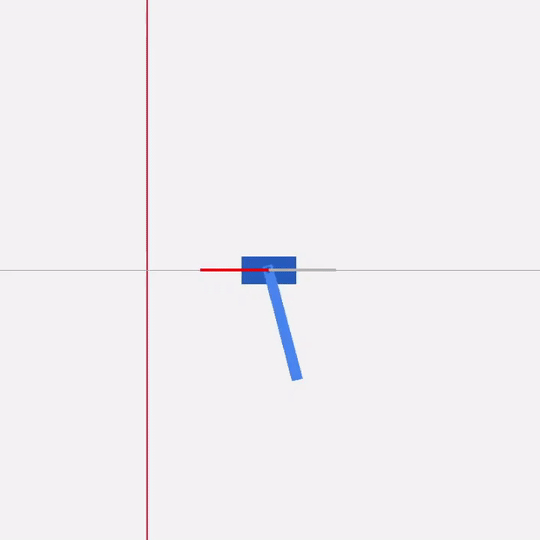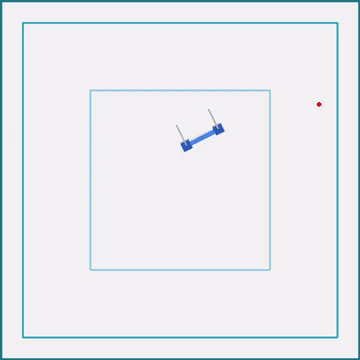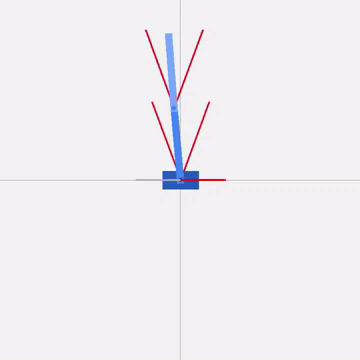This repository contains OpenAI Gym environment designed for teaching RL agents the ability to bring the cartpole upright and its further balancing. To make this easy to use, the environment has been packed into a Python package, which automatically registers the environment in the Gym library when the package is included in the code. As a result, it can be easily used in conjunction with reinforcement learning libraries such as StableBaselines3. There is also a sample code for training and evaluating agents in this environment.
These instructions will guide you through installation of the environment and show you how to use it for your projects. Whichever method of installation you choose I recommend running it in a virtual environment created by Miniconda. This program is used to simplify package management and deployment.
So, to get started, install Miniconda, here is the official installation guide along with a detailed description.
In the following way you can create and activate virtual environment:
conda create -n <environment_name> python=3.9
conda activate <environment_name>
You just need to type
pip install single-cartpole-custom-gym-env
If you want to make specific changes to the source code or extend it with your own functionalities this method will suit you.
git clone https://github.com/marek-robak/Single-cartpole-custom-gym-env-for-reinforcement-learning.git
cd Single-cartpole-custom-gym-env-for-reinforcement-learning/single_cartpole_custom_gym_env_package
pip install -e .
Now all you need to do to use this environment in your code is import the package. After that, you can use it with Gym and StableBaselines3 library via its id: single-cartpole-custom-v0.
from stable_baselines3 import PPO
import gym
import single_cartpole_custom_gym_env
env = gym.make('single-cartpole-custom-v0')
model = PPO("MlpPolicy", env)
model.learn(total_timesteps=1500000)
model.save('new_agent')
Environment to run needs Python3 with Gym, Pygame, Pymunk, Numpy and StableBaselines3 libraries. All of them are automatically installed when the package is installed.
This environment consists of a cart attached to a straight rail and an inertial pendulum loosely attached to the cart. The RL agent can control the force acting on the cart. This force influences the movement of the cart, which then translates into the swing angle of the pendulum. The pendulum and the cart separately are rigid bodies with the same mass. The agent's goal is to learn how to place the pendulum vertically and then transport the cartpole to a randomly designated point on the rail. Both the forces acting on the cart and the target point on the rail are marked with red lines.
The physics engine for this environment runs at 60fps.
At the beginning of each episode, the cartpole is placed in the center of the available space. Then, the initial inclination of the pendulum to the vertical axis from 0° to 20° is drawn. The location of the target is also randomized.
Each episode ends if the cart goes off-screen or if the set number of timesteps has passed.
The space of actions made available to the RL agent consists of one value from -1 to 1. It is correlated with the force acting on the cart, -1 and 1 are maximum forces, 0 is no force acting.
The observation space consists of fours values, all ranging from -1 to 1.
- The first one carries information about the distance of the cart from the walls and the target point. A 0 is returned when the cart is at the target point and values -1 and 1 when the cart touches the left or right wall.
- The second number informs about the current swing angle of the pendulum. It is scaled to return 0 for a vertically upward pendulum, and -1 and 1 for a downward pendulum.
- The third number contains information about the speed at which the cart is moving. It has been graduated so that the values -1 and 1 represent the maximum possible speed that the cart can develop in the available space.
- The fourth number contains information about the angular velocity of the pendulum. It has been scaled so that the values -1 and 1 represent the maximum achievable values.
The task that the agent must perform consists of two phases. In the first one, it has to swing the pendulum vertically. In the second, while keeping the balance, it has to move the cart to the target point. For this reason, the reward function has been split into two expressions. The first is the weighted sum of the linear dependencies of the pendulum deflection angle and its distance from the target. It is awarded when the pendulum is inclined from the vertical by an angle of more than 10°. The values of the parameters of this sum were selected to promote the swing of the pendulum more than to transport the cart to its destination. The second formula works when the angle of the pendulum to the vertical is less than 10°. In this phase, the agent must be concerned mainly with not losing his balance and transporting the cart closer to the target point. For this reason, this part of the function is a linear dependence of only the distance of the cart from the target plus a penalty for loss of balance. The agent is also penalized for hitting a cart against a wall.
Variables x and 𝛼 are the first and second values from the agent observation space.
This environment provides two parameters that can change the way it works.
- render_sim: (bool) if true, a graphic is generated
- n_steps: (int) number of time steps
env = gym.make('single-cartpole-custom-v0', render_sim=True, n_steps=1000)
Everything available in this repository was created for the needs of my bachelor thesis. If you can read in Polish and you are interested in it, you can find it here. It includes details on the training process for sample agents and a description of the reward function selection process.
You may also be interested in other environments I have created. Go to the repositories where they are located by clicking on the gifs below.


